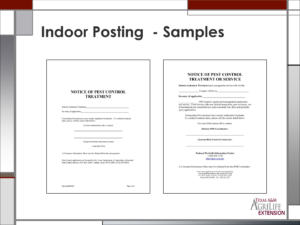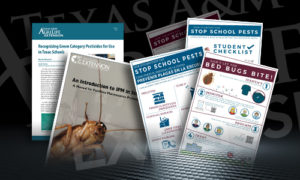In this newsletter we are going to look at some of the more frequent problems that are encountered during a school integrated pest management (IPM) inspection by the Texas Department of Agriculture (TDA).
Texas is one of the few states that require all persons who apply pesticides to hold a noncommercial applicator license if they make applications not just in schools but other locations as well. Under the Occupations Code Chapter 1951 the following employees must be licensed if they apply pesticides:
- State government employees and/or
- Persons performing pest control at:
- An apartment building
- School/Day-care center
- Hospital/nursing home
- Hotel/motel/lodge
- Warehouse
- Food-processing plant (other than a restaurant, retail food, or food service establishment)
Structural pest control includes, but is not limited to, pests that may infest:
- parks
- buildings or structures and adjacent areas (perimeter of a building)
- industrial plants
- streets
- docks
- railroad cars
- trucks
- ships
- airplanes.
Under the Texas Administrative Code, Agricultural Section, Title 2, TDA licenses pesticide applicators who apply restricted-use and state-limited-use pesticides and regulated herbicides. For public school districts, this also includes general use insecticides, herbicides, and fungicides on all outdoor grounds. This inclusion falls under the Structural Pest Control Rules for Integrated Pest Management Program for School Districts, which requires anyone using a pesticide to have a license. While this might seem burdensome, we must remember that we all work in the public environment and public safety is at the forefront for school administrators. Pesticide licensing demonstrates that you care about student safety.

The sign on the left is the standard 48 posting notification that TDA publishes on their website. The sign on the right is something AgriLife Extension developed with TDA for schools to use.
Posting is another aspect of pesticide safety that will need to be maintained. Any treatment done indoors requires 48 hours prior notification. If your pest control company is not ensuring you have this sign, 48 hours in advance call them and ask why. It is up to the school IPM coordinator or building manager to ensure that 48 hours prior to any indoor treatment that the building is posted. Posting serves notice to all building occupants that there may be an insecticide treatment in two days. In addition to the indoor posting, all outdoor treatments for any type of pesticide application (excludes fertilizer) should also be posted. The type of treatment will determine how long the sign will remain up. If your applicator is using a Green Category pesticide, then once the treatment is done the sign can come down provided the label does not require a longer re-entry. For Yellow Category products like herbicides with a Caution signal word, the reentry time is 4 hours after the application is complete. Finally, Red Category products, which carry a Warning or Danger signal word or restricted use pesticide, signs must stay in place 8 hours after the application is complete.
Parental notification is part of the school IPM rules. Parental notification requires school districts to send a notification to all parents at the beginning of the school year informing parents to contact the IPM Coordinator regarding concerns about pesticide products used at the school. This enables the coordinator to keep track of children who might have a chemical sensitivity or allergies to certain pests. In some cases, the school nurse may know; but does the school nurse know when the pest control company is coming to service the school? With so many different types of allergies, asthma triggers, and kids who have compromised immune systems, this notification process ensures that schools don’t contribute to poor student health.
Finally, what do you do if your IPM Coordinator retires or a budget reduction has your IPM Coordinator laid off? Don’t panic, but it is important that the Superintendent appoint an IPM Coordinator as soon as possible in order to remain compliant with School IPM legislation. Per the rules, the coordinator needs to report to TDA within 90 days that there has been a change. The Legislative Budget Board mandates TDA to inspect 20% of Texas public school districts every year. A common inspection issue is failure to have a designated or a trained IPM coordinator. New IPM coordinators must attend an approved six-hour school IPM coordinator training within six months of appointment. Incumbent IPM coordinators must have six hours of continuing education every three years. One thing I have learned over my career helping schools with their IPM programs is you can never have enough training on this subject to pests, pesticides and conditions change too much and you must be aware of everything.

Drs. Don Renchie and Mike Merchant instruct at one of our two-day regional classes which is the best way to stay up to date on staying compliant with TDA rules.
Texas A&M AgriLife Extension offers two-day training workshops that provide this required IPM Coordinator training. The first day addresses IPM Coordinator training and satisfies the mandated training requirement. The second day focuses on pesticide application and provides CEUs for applicator license recertification. License holders and IPM coordinators can obtain 5 of the approved continuing education credits for school IPM refresher certification, but at least 1 hour in school IPM specifically is needed to follow TDA rules.
IPM is a strategy of managing pests using multiple control tactics that provide the best control with the least cost and environmental impact. IPM is based on thorough knowledge of pests and the technologies used to control them. IPM is a process that requires cooperation among all staff members within your school district as well as your pest control company; it can be performed by anyone with proper training. A good IPM program makes schools less hospitable to pests by modifying the environment and by using the lowest impact pesticides as necessary. Managing risks from pests and pesticides are top priorities and, no matter what the law may be, this is something every administrator should want to accomplish.
Here are a few of our resources to help you accomplish your IPM program goals:
48 Hour Posting Notification for schools PestControlNotificationSign – Schools
Yellow or Red Category Justification Form Justification form
For outdoor posting you can ask your lawn care provider for signs or Gempler’s has them
Recognizing Green Category Products Fact Sheet Recognizing Green Category Products for Schools
Recordkeeping form in Excel Pest Control Use Records combo Ag and SPCS

School IPM Educational Materials to help you teach everyone about IPM. Visit our AgriLife Extension Bookstore to order yours today

 .
.